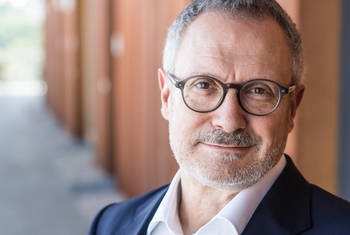Christina Warinner What Does Dental Calculus Reveal About Human Evolution?
Christina Warinner is Associate Professor of Microbiome Sciences at the Max Planck Institute for Science of Human History’s Department of Archaeogenetics in Jena, Germany. In 2010, she received her PhD from Harvard University and went on to do postdoctoral training at the University of Zurich (Switzerland) and later the University of Oklahoma (USA), where she co-founded the Laboratories for Molecular Anthropology and Microbiome Research. Warinner’s research on evolutionary medicine and the evolution of the human oral microbiome has been ground breaking. She and her research group were the first to publish a detailed genomic and proteomic study of the ancient human oral microbiome, and she is pioneering new methods for ancient dietary and human genome reconstruction. These achievements and the research advancements she has made in her field earned her a TED Fellowship in 2012 and an invitation to the White House Microbiome Innovation Forum in 2015.
Area of Research
Evolutionary Medicine
since 2016
Associate Professor
Max Planck Society (more details)
Max Planck Institute for the Science of Human History
since 2014
Adjunct Professor
University of Oklahoma
Department of Periodontics, College of Dentistry
since 2014
Assistant Professor
University of Oklahoma
Department of Anthropology
since 2014
Presidential Research Professor
University of Oklahoma
2015
Visiting Associate Professor
Technical University of Denmark
Department of Systems Biology
2012-2014
Research Associate
University of Oklahoma
Department of Anthropology
2011-2012
Acting Head of Group
University of Zurich (Universität Zürich)
Centre for Evolutionary Medicine
2010-2011
Research Assistant
University of Zurich (Universität Zürich)
Centre for Evolutionary Medicine
2010
PhD in Anthropology
Harvard University
Department of Anthropology
2008
Master in Anthropology
Harvard University
Department of Anthropology
2003
Bachelor in Anthropology
University of Kansas
2003
Bachelor in Germanic Literatures and Languages
University of Kansas
Fellowships
- Center for Academic Research and Training in Anthropogeny (CARTA) Invited Member (2016)
- Invited Participant, White House Microbiome Innovation Forum, Office of Science and Tech. Policy (2015)
- Editorial Board, Scientific Reports (since 2015)
- Kavli Foundation Fellow, United States National Academy of Sciences (2014)
- TED Fellow (2012)
- Science Foo Camp (“SciFoo”), Invited Scientist, Sponsored by Nature, O’Reilly Media, and Google (2012)
- Cora du Bois Charitable Trust Writing Fellowship (2009)
- NSF Graduate Research Fellowship (2004)
Prizes
- Omenn Prize Honorable Mention, International Society for Evolution, Medicine and Public Health (2014)
- Research and Impact Visitor Travel Award, University of York (2013)
- Distinction in Teaching, Derek Bok Center for Teaching and Learning, Harvard University (2006, 2007)
- Microbial Ecologies of Indigenous Communities, Co-PI, US National Institutes of Health (R01GM089886) (2016-2020)
- EAGER: Identification of Specific Pathogens in Human Dental Calculus, Co-PI, US National Science Foundation, Biological Anthropology Program (BCS-1643318) (2016-2018)
- Direct Proteomic Investigation of Dairying in the Near Eastern and European Neolithic, PI, US National Science Foundation, Archaeology Program (BCS1523264) (2015-2018)
- Evolution and Ecology of the Human Oral Microbiome, PI, US National Science Foundation, Biological Anthropology Program (BCS1516633) (2015-2017)
- Testing Models of Population History and High Altitude Adaptation in Lo Manthang, Upper Mustang, Nepal, Within a Multidisciplinary Framework (2015-1017)
- Investigating the Effects of the Industrial Revolution on Oral Biology and Health Senior Investigator, Fell Fund, University of Oxford, UK (EBD10130) (2015-2016)
- Ancient DNA and Paleoprotein Investigation of Dairying and the Evolution of Swiss Diet PI, Swiss Foundation for Nutritional Research (#440) (2011-2012)
 © Maximilian Dörrbecker
© Maximilian Dörrbecker
Max Planck Society
"The Max Planck Society is Germany's most successful research organization. Since its establishment in 1948, no fewer than 18 Nobel laureates have emerged from the ranks of its scientists, putting it on a par with the best and most prestigious research institutions worldwide. The more than 15,000 publications each year in internationally renowned scientific journals are proof of the outstanding research work conducted at Max Planck Institutes – and many of those articles are among the most-cited publications in the relevant field." (Source)
Institute
Max Planck Institute for the Science of Human History
The Max Planck Institute for the Science of Human History conducts basic research using modern analytical methods with the aim of a multidisciplinary and integrated science of human history. It seeks to bridge the gap between historical disciplines and the natural sciences. Scientists from a range of fields, such as biology, linguistics, archaeology, anthropology and history jointly work on innovative methods, in particular in the fields of cutting-edge genetic and proteomic sequencing, bioinformatics, archaeological science, computational modeling, language databases, and phylogeography. This thoroughly integrated, interdisciplinary approach will address long-standing questions about human history – including some previously deemed difficult, or even completely intractable – as well as novel questions inspired by the new horizons that cutting edge methods open up. (Source)
Map
Dental calculus, a calcified form of tooth plaque, can give detailed information about the diets, diseases and lifestyles of past humans. CHRISTINA WARINNER discusses how she gains new knowledge about the way human beings used to live, what they ate, and how their microbiome has evolved. Dental calculus is the richest known source of ancient DNA in the archaeological record, and it is the only part of the body that fossilizes during life. In this video, she explains how emerging technologies in genomics and proteomics are contributing to groundbreaking discoveries about past human health and diet. By combining genetic and protein data, she describes how ancient infections leave behind sufficient traces to reconstruct entire pathogen genomes, as well as a detailed snapshot of host immune response. She explains how studies of ancient dental calculus will help us understand how our microbiome has evolved and why understanding the human ancestral microbiome may shed light on current chronic health problems.
LT Video Publication DOI: https://doi.org/10.21036/LTPUB10321
Pathogens and Host Immunity in the Ancient Human Oral Cavity
- Christina Warinner, João F. Matias Rodrigues, Rounak Vyas, Christian Trachsel, Natallia Shved, Jonas Grossmann, Anita Radini, Yvette Hancock, Raul Y. Tito, Sarah Fiddyment, Camilla Speller, Jessica Hendy, Sophy Charlton et al
- Nature Genetics
- Published in 2014









